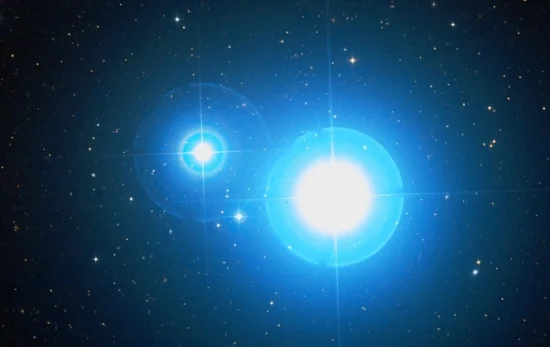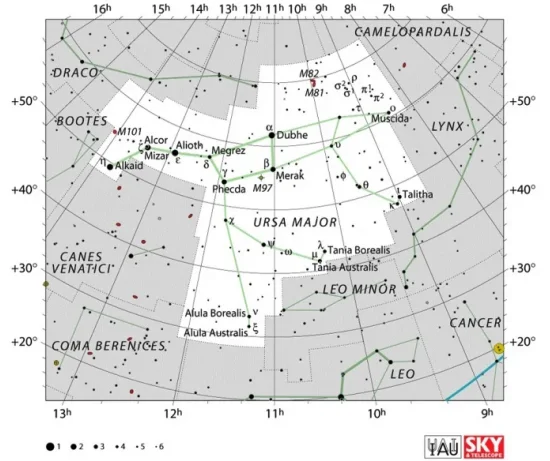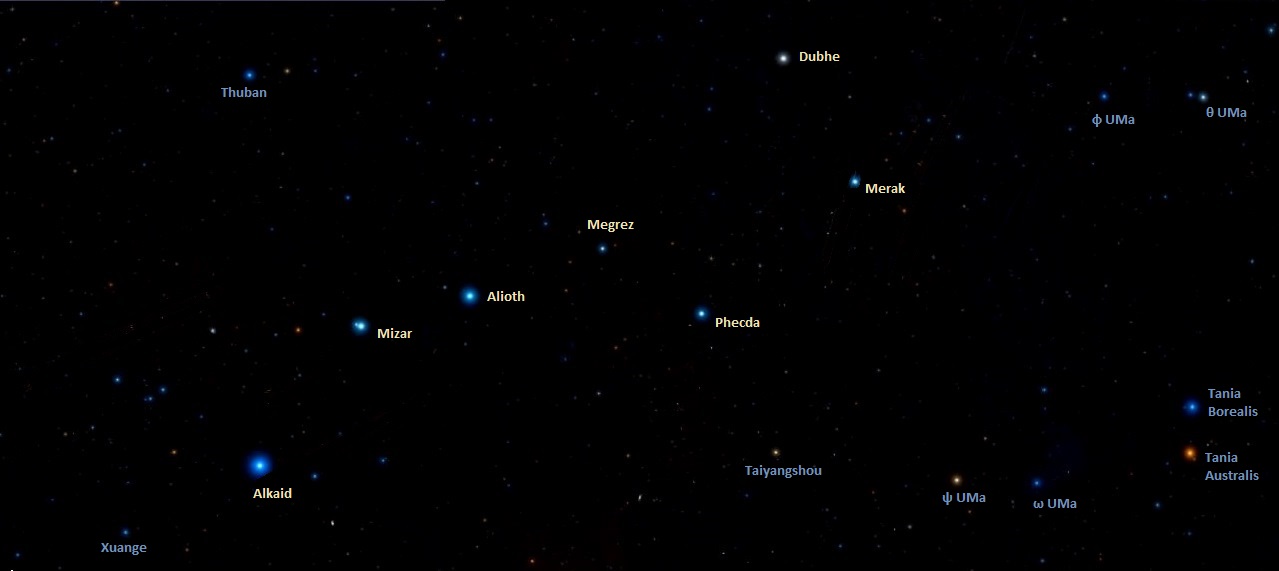Alcor is a double star in the constellation Ursa Major. It is the fainter companion to Mizar, the middle star in the handle of the Big Dipper. Alcor has the Bayer designation g Ursae Majoris and the Flamsteed designation 80 Ursae Majoris. It lies at an approximate distance of 81.7 light years from Earth and has an apparent magnitude of 3.99.
Star system
Alcor is a binary star system composed of a white main sequence star of the spectral type A5Vn and a dim red dwarf with the stellar classification M3-4V. The two stars are separated by only 1 second of arc.
Alcor A has 1.84 solar masses and a radius 1.846 that of the Sun. With an estimated temperature of 8,221 K, it is about 14 times more luminous than the Sun. The star is a very fast spinner, with a projected rotational velocity of 228 km/s.
The class M companion, Alcor B, is considerably smaller and has only 0.25 solar masses.

Alcor and Mizar, image: Wikisky
Mizar and Alcor
Mizar and Alcor make a visual double and are a popular target for binoculars and small telescopes. Alcor is located only 11.8 arcminutes northeast of Mizar. The stars share a common proper motion, which means that they are moving through space together, along with other members of the Ursa Major Moving Group.
The pair were thought to the physically unrelated until 2009, when two separate teams of astronomers discovered that Alcor was a binary star and that it was indeed gravitationally bound to Mizar. If this is proven beyond question – it has not been yet because the exact distance of the stars is still uncertain – it will mean that Mizar and Alcor are in fact a sextuple star system.
The two stars are also closer than previously believed, with an estimated distance between them of only 0.5 to 1.5 light years, or 74,000 ± 39,000 astronomical units. If both stars lie at the exact same distance from Earth, then the estimated distance between them is no more than 0.281 light years, or 17,800 astronomical units. This, however, is slightly unlikely.
Facts
Alcor is a member of the Ursa Major Moving Group, a group of stars formed in the same molecular cloud about 300 million years ago, that share common velocities and motion through space. Big Dipper stars Mizar, Alioth, Megrez, Phecda and Merak are also members of the group, as are many other relatively bright stars, including Menkalinan (Beta Aurigae), Alphecca (Alpha Coronae Borealis), Beta Serpentis, Skat (Delta Aquarii), Adhafera (Zeta Leonis) and Chi1 Orionis.
Alcor is one of the few stars that do not have a Bayer designation beginning with a Greek letter, but do have a proper name nonetheless. A great number of significantly brighter stars with Greek letter designations do not yet have a name.
Many old Arabic texts refer to Mizar’s companion being an excellent test of eyesight. While it is easy enough to assume that the companion in question is Alcor, since one does not need to have perfect eyesight to see the star, the English amateur astronomer Sir Patrick Moore has suggested that the texts referred to Ludwig’s Star, a much fainter star (8th magnitude) that appears between Mizar and Alcor. Ludwig’s Star (Sidus Ludoviciana) has the spectral type A8/F0 III and is about five times more distant from us than Mizar and Alcor. The star was discovered (and mistaken for a planet) by the German astronomer Johann Georg Liebknecht in December 1722. Liebknecht named it after his patron, Louis V, Landgrave of Hesse-Darmstadt.
Name
The International Astronomical Union’s (IAU) Working Group on Star Names (WGSN) officially approved the name Alcor (pronunciation: /ˈælkɔːr/) for 80 UMa Ca on June 30, 2016.
Alcor was originally called Suhā or Sohā in Arabic, meaning “the forgotten one” or “the neglected one.” The name was a reference to the star’s faintness compared to the brighter Mizar. Alcor is also mentioned as al-Khawwar, or “the faint one,” on a list of Arabic names compiled by Professor Robert H. West of the Syrian Protestant College in Beirut, Lebanon and published in Popular Astronomy in 1895.
Alcor’s Latin name was Eques Stellula, or the Little Starry Horseman. Johann Bayer referred to it as Eques, the Cavalier.
Mizar and Alcor are sometimes known as the “Horse and Rider.”
The Japanese knew the star as jumyōboshi (寿命星), meaning “the lifespan star.” They believed that a person who could not see Alcor would not live another year. The legend is used in the Japanese manga Fist of the North Star.
In Indian astronomy, Alcor was known as Arundhati, the wife of Vashishtha, one of the Saptarishi (Seven Sages), represented by Mizar. Arundhati and Vashishtha symbolized marital closeness.
Myth
Ancient Greeks sometimes associated Alcor with Electra, the lost Pleiad, who was said to have wandered to this area and become Alopex, or the Fox. In mythology, Electra withdrew her light after the fall of Ilium, mourning the demise of her descendants. Dardanus, her son with Zeus, was an ancestor of King Priam of Troy and his children. (The star Electra is in fact one of the Pleiades, the Seven Sisters. It has the Flamsteed designation 17 Tauri and is the third brightest member of the M45 open cluster.)
In a Norse myth, Alcor represents one of the toes of Orwandil, the Giant. Orwandil himself is represented by the constellation Orion and the bright Rigel represents his other toe. In the myth, Orwandil was frostbitten and the god Thor broke off his frozen toe and threw it to the northern sky, where it became Alcor.
In old Arabic astronomy, the stars of the Big Dipper represented a funeral procession. The stars that form the Dipper’s Bowl – Megrez, Phecda, Dubhe and Alioth – represented the coffin, while the stars of the handle represented the mourners. Alcor represented an infant held by one of the mourners.
Mizar and Alcor were associated with the Mi’kmaq First Nations myth of the seven hunters chasing the great bear. In the myth, the hunters (birds), symbolized by the three stars of the Big Dipper’s handle (Alkaid, Mizar and Alioth) and four stars in Boötes constellation, hunt the bear, represented by the stars of the Big Dipper’s bowl (Megrez, Phecda, Dubhe and Merak). Mizar represents Chickadee, one of the hunters, and Alcor marks the cooking pot in which he cooks the bear. The myth explains why leaves turn red in the autumn – when the hunters catch up with the bear, its blood spatters over the earth, dripping on the trees – as well as why the Big Dipper changes its position in the sky from spring to winter (because the bear’s skeleton lies on its back in the winter until its spirit enters another bear, which leaves its cave in the spring only to be hunted again).
Location
Alcor is easy to find because of its proximity to Mizar and the Big Dipper. Located next to the tail of the Great Bear, the star can easily be seen just above its brighter neighbour Mizar, the middle star of the Big Dipper’s handle or the Great Bear’s tail.
Constellation
Alcor lies in the constellation Ursa Major, the largest northern constellation and third largest of all 88 constellations, after Hydra and Virgo. Associated with the myth of Callisto, the nymph Hera/Juno turned into a bear, the constellation represents the Great Bear. Ursa Major is circumpolar in mid-northern latitudes because, as the myth explains, Hera was angered when Zeus transformed Callisto into a constellation and she asked Tethys to never let the bear come near her waters.

Ursa Major constellation map by IAU and Sky&Telescope magazine
The bright deep sky objects appearing nearest to Alcor are the famous Pinwheel Galaxy (Messier 101) in Ursa Major and the Whirlpool Galaxy (Messier 51) in Canes Venatici.
Ursa Major is home to many other notable deep sky objects, including the galaxy pair Messier 81 (Bode’s Galaxy) and Messier 82 (the Cigar Galaxy), the barred spiral galaxies Messier 108 and Messier 109, and the Owl Nebula, a bright planetary nebula named for its striking resemblance to an owl.
Ursa Major is circumpolar from most locations north of the equator and can be seen throughout the year. The best time of year to observe its stars and deep sky objects is during the spring months, when it dominates the evening sky.
The 10 brightest stars in Ursa Major are Alioth (Epsilon UMa, mag. 1.77), Dubhe (Alpha UMa, mag. 1.79), Alkaid (Eta UMa, mag. 1.86), Mizar (Zeta UMa, mag. 2.04), Merak (Beta UMa, mag. 2.37), Phecda (Gamma UMa, 2.438), Psi Ursae Majoris (mag. 3.01), Tania Australis (Mu UMa, mag. 3.06), Talitha (Iota UMa, mag. 3.14), and Theta Ursae Majoris (mag. 3.166).
Alcor – g Ursae Majoris
| Spectral class (Alcor A, Alcor B) | A5Vn, M3-4 V |
| Apparent magnitude | 3.99 |
| Absolute magnitude | +2.00 |
| Distance | 81.7 ± 0.3 light years (25.06 ± 0.08 parsecs) |
| Parallax | 39.91 ± 0.13 mas |
| Radial velocity | -9.6 km/s |
| Proper motion | RA: 120.21 mas/yr |
| Dec.: -16.04 mas/yr | |
| Mass (Alcor A, Alcor B) | 1.84 M☉, 0.25 M☉ |
| Luminosity (Alcor A) | 14.03 L☉ |
| Radius (Alcor A) | 1.846 R☉ |
| Temperature (Alcor A) | 8,221 K |
| Age (Alcor B) | 0.5 ± 0.1 billion years |
| Rotational velocity (Alcor A) | 228 km/s |
| Surface gravity (Alcor A) | 4.25 cgs |
| Constellation | Ursa Major |
| Right ascension | 13h 25m 13.53783s |
| Declination | +54° 59′ 16.6548” |
| Designations | Alcor, 80 Ursae Majoris, g Ursae Majoris, HD 116842, GC 18155, HIP 65477, SAO 28751, PPM 34021, HR 5062, BD+55 1603, WDS J13239+5456C, CCDM J13240+5456D, GSC 03850-01384, GJ 3785, TYC 3850-1384-1, Gaia DR2 1565090003969283968, 2MASS J13251353+5459165 |
